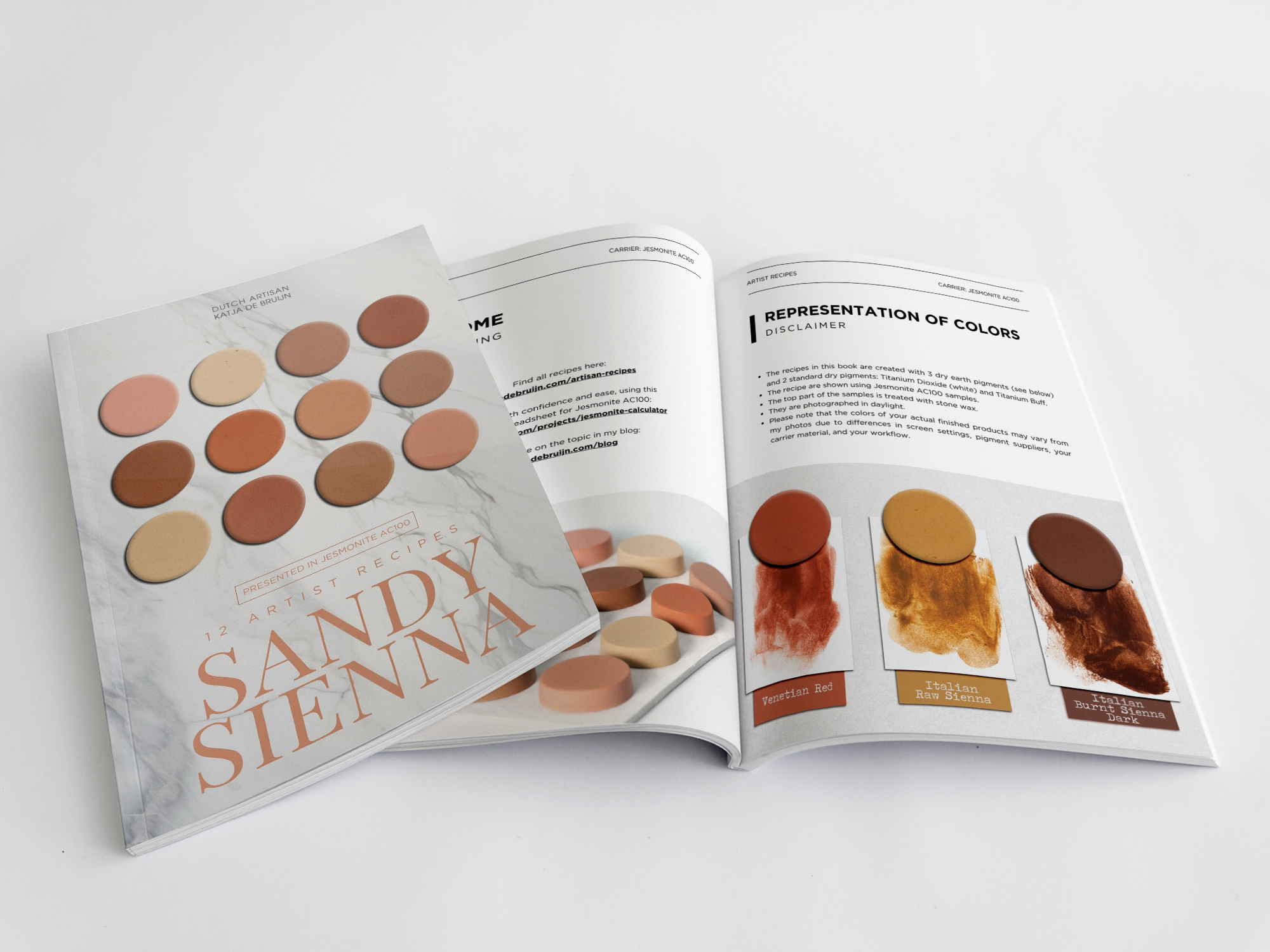I offer numerous color recipes for Jesmonite with dry pigments. They differ from Jesmonite Pigments and acrylic paints, consisting solely of genuine, unaltered pigments in powder form. I exclusively work with lightfast and non-toxic pigments of both natural and synthetic origin. I recommend to steer clear of pigments containing cadmium, cobalt, or other toxic substances.
Dry pigments may not suit artists aiming for very uniform coloration. However, they’ve become my preference for terrazzo, marbling, mottling, and similar effects due to their high color intensity, precise dosage, wide variety, and relative affordability compared to liquid alternatives.
Pigments are typically grouped into large families. Earth pigments, composed of naturally occurring minerals and clays, offer a historical charm and a wide array of beautiful colors, albeit with occasional clumping issues. Iron oxide pigments, highly tinting and stable, are commonly used in concrete production and outdoor applications, though I use them sparingly due to their potential staining properties. Modern age pigments, chemically produced, offer varying performance in gypsum, with favorites including phthalos, pyrroles, and quinacridones.
Many suppliers will ship dry pigments in bags. Please note that pigment powders are extremely light and dusty! Additionally, some of them (like iron oxides) are also particularly tinting, so even a tiny spillage may cause an irreparable stain on any surface it comes into contact with. Therefore, I always transfer pigments into reliable jars with good screw-on lids immediately upon opening. For your reference, 100 grams of dry pigment will usually fit into a 200 ml jar. For a kilo of pigment, you might want to acquire two 1-liter jars. Self-premade pigment mixtures shall expand your working palette. I prefer to store mine in 40 ml jars.
You can source pigment powders by noting their exact name and number (for example, Phthalo Green Yellow Shade PG 36) at shops that sell supplies for professional artists, as well as shops for concrete production. Depending on both the supplier and your carrier material, the color results from these recipes may differ. For example, regular porcelain gypsum will likely yield more subtle colors than Jesmonite.
Invest in a high-precision scale because you will need to weigh pigments to the tenth of a gram.
Want to save tons of time measuring everything?
Download my all-inclusive Jesmonite spreadsheet here >>
I have never tested more than 4% dry pigment load in Jesmonite. If you wish to exceed dry pigment load, ensure thorough testing on your products. Generally, 2-4% is sufficient.
I usually weigh the dry pigment, add the Jesmonite Liquid, mix them for a bit, then I add the powder, and mix everything well again. I’ve noticed that with this method, the pigment diluted in liquid increases its dispersion, and its coloring ability improves. I mix with a kind of spatula (plastic or silicone) that allows to scrape the walls of my mixing cup.
Work with gloves and a facial mask. Protect your working surface with cellophane foil, which is an affordable option available in rolls at shops that sell supplies for florists. Precut pieces of such foil are also great for rolling out a terrazzo cast. I clean spilled pigments with a cloth and a concentrated dishwasher detergent. Alcohol wipes can be used for spilling incidents.
Drying times, sanding methods, and sealing items made with dry pigments are rarely different from other colorants. Wait for 24 hours (up to 48 hours for large items) before sealing. Personally, I prefer using stone wax polish (currently using Clark’s, but open to trying others!) as it revives colors and makes surfaces water-repellent.
You can absolutely combine various pigments together, for example, an earth pigment with some synthetic pigment. However, do keep in mind that not all pigments can withstand outdoor conditions, acrylics, acids and alkalis.

